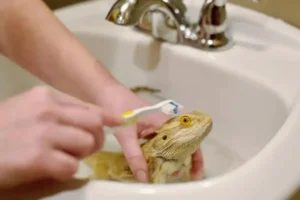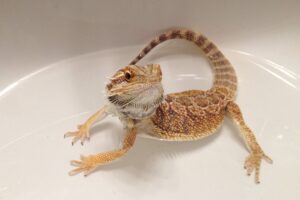So, you’ve got this awesome bearded dragon in your life, and you want to make sure they’re living their best scaly existence, right? Well, guess what? Bath time is a key element of their care routine, and we’re here to guide you through the process.
In this article, titled “How to Bathe a Bearded Dragon,” we’ll cover all the ins and outs of giving your dragon buddy a spa day they won’t forget. Whether you’re a seasoned reptile parent or a newbie, buckle up as we dive into the world of bearded dragon baths and uncover the secrets to keeping your scaly friend happy and healthy.
How to Bathe a Bearded Dragon

Bathing a bearded dragon is an important aspect of their care routine, as it helps with hydration and maintaining good hygiene. Here’s a step-by-step guide on how to bathe a bearded dragon:
1. Gather Supplies:
- Shallow container or sink: Ensure it’s big enough for your bearded dragon to comfortably sit in without drowning.
- Lukewarm water: The water should be around 85-100°F (29-38°C). Use a thermometer to check the temperature.
- Soft brush or toothbrush: To help remove shed skin if necessary.
- Towels: For drying your bearded dragon afterward.
- Timer: To keep track of the bathing time.
2. Prepare the Bathing Area:
- Place the shallow container or sink in a quiet and calm area where your bearded dragon can relax.
- Make sure the water level is no higher than the dragon’s elbows when it’s sitting in the water.
3. Check the Water Temperature:
- Use a thermometer to verify that the water is at the appropriate temperature range (85-100°F or 29-38°C).
4. Introduce Your Bearded Dragon to the Water:
- Gently pick up your bearded dragon and place it in the shallow water. Support its body to make it feel secure.
5. Allow Your Dragon to Soak:
- Let your bearded dragon soak for about 10-15 minutes. This helps them hydrate and may also aid in the shedding process.
6. Monitor Behavior:
- Keep an eye on your bearded dragon during the bath. Some dragons may enjoy splashing, while others may prefer to sit calmly.
7. Gently Clean if Necessary:
- If your dragon has shed skin, you can use a soft brush or toothbrush to gently rub the areas where the skin is stuck. Be very gentle to avoid causing any stress or harm.
8. Dry Your Bearded Dragon:
- Once the bath is complete, carefully lift your bearded dragon out of the water and place it on a towel. Gently pat it dry.
9. Return to Enclosure:
- Return your bearded dragon to its enclosure once it’s completely dry. Ensure the enclosure is warm to prevent chilling.
10. Frequency:
- For most bearded dragons, a bath 1-2 times a week is sufficient. However, if your dragon is experiencing shedding issues, more frequent baths may be necessary.
Always monitor your bearded dragon during the bath to ensure it feels comfortable and safe. If your dragon shows signs of stress or discomfort, such as trying to escape, end the bath and try again later. Additionally, make sure to clean and disinfect the bathing container after each use.
Importance of proper hygiene for bearded dragons
Proper hygiene is crucial for the well-being of bearded dragons, as it helps prevent various health issues and ensures a healthy and comfortable living environment. Here are some reasons highlighting the importance of proper hygiene for bearded dragons:
- Preventing Infections:
- Bearded dragons are susceptible to bacterial and fungal infections. Maintaining a clean environment, including their enclosure and accessories, reduces the risk of these infections.
- Shedding Assistance:
- Bearded dragons shed their skin regularly as they grow. A clean and humid environment, along with regular baths, helps facilitate the shedding process and reduces the likelihood of retained shed, which can lead to complications.
- Avoiding Respiratory Issues:
- Accumulation of waste, dust, or mold in the enclosure can contribute to respiratory problems in bearded dragons. Regular cleaning helps maintain air quality and reduces the risk of respiratory infections.
- Preventing Parasites:
- Poor hygiene can lead to the development and spread of parasites, such as mites and worms. Regular cleaning and proper substrate maintenance help minimize the risk of parasites affecting your bearded dragon.
- Maintaining Healthy Skin and Scales:
- Clean and well-moisturized skin is essential for the overall health of bearded dragons. Regular baths and a clean environment contribute to healthy skin and scales, preventing dryness, irritation, or infections.
- Ensuring Adequate Nutrition:
- Clean feeding and drinking areas are crucial to prevent the growth of harmful bacteria. Proper hygiene in these areas ensures that your bearded dragon’s food and water are free from contaminants, promoting overall health.
- Reducing Stress:
- A dirty and unsanitary environment can stress bearded dragons. Stress weakens their immune system, making them more susceptible to diseases. A clean and well-maintained enclosure contributes to a stress-free and comfortable living space.
- Preventing Impaction:
- Bearded dragons may accidentally ingest substrate or foreign objects, leading to impaction. Regular cleaning and using substrates that are safe for ingestion help minimize the risk of impaction.
- Promoting Overall Well-being:
- Good hygiene practices contribute to the overall health and well-being of your bearded dragon. A clean and comfortable environment supports their physical and mental health, allowing them to thrive.
To maintain proper hygiene for your bearded dragon, establish a regular cleaning routine for the enclosure, regularly clean and disinfect accessories, provide a clean water source, and conduct routine health checks. Additionally, pay attention to your bearded dragon’s behavior and appearance, as changes may indicate underlying health issues that require prompt attention.
Understanding Bearded Dragon Bathing Needs



